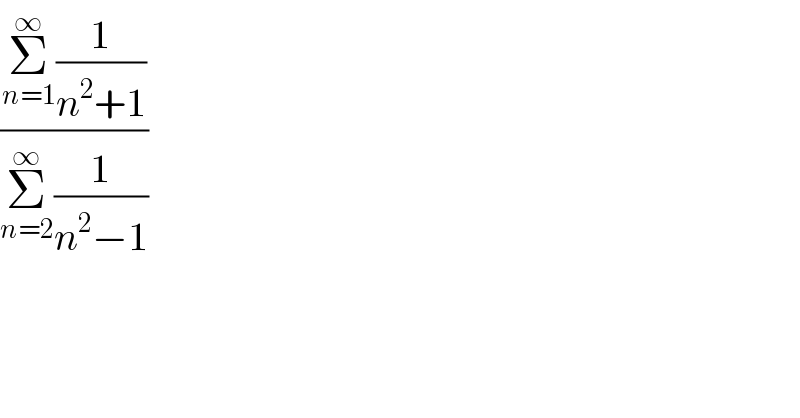
Question and Answers Forum
Question Number 121326 by Dwaipayan Shikari last updated on 06/Nov/20

Commented by Dwaipayan Shikari last updated on 06/Nov/20
![Σ_(n=2) ^∞ (1/(n^2 −1))=(1/2)(Σ_(n=2) ^∞ (1/(n−1))−Σ_(n=2) ^∞ (1/(n+1)))=(1/2)(1+(1/2)+(1/3)+...−(1/3)−(1/4)−...) =(3/4) Σ_(n=1) ^∞ (1/(n^2 +1))=(1/(2i))Σ_(n=1) ^∞ (1/(n−i))−(1/(n+i)) =(1/(2i))Σ_(n=2) ^∞ ((1/n)−(1/(n−i−1)))−(1/(2i))Σ_(n=2) ^∞ ((1/n)−(1/(n+i−1))) =(1/(2i))(ψ(i)−ψ(1−i)) =(1/(2i))(−πcot(iπ))+i) = (1/(2i))(−πcot(iπ)+1))=(π/2)cothπ+(1/2) [Γ(s)Γ(1−s)=(π/(sinπs))] [log(Γ(s)+log(Γ(1−s))=logπ−log(sinπs)] [((Γ′(s))/(Γ(s)))−((Γ′(1−s))/(Γ(1−s)))=−((πcossπs)/(sinπs))] [𝛙(1−s)−𝛙(s)=πcotπs]](Q121331.png)
Commented by Dwaipayan Shikari last updated on 06/Nov/20

Commented by mathmax by abdo last updated on 06/Nov/20

Answered by mathmax by abdo last updated on 06/Nov/20
![let f(x) =e^(−∣x∣) function 2π periodic even we have f(x) =(a_0 /2) +Σ_(n=1) ^∞ a_n cos(nx) with a_n =(2/T)∫_T f(x)cos(nx)dx =(2/(2π))∫_(−π) ^π e^(−∣x∣) cos(nx)dx =(2/π)∫_0 ^π e^(−x) cos(nx)dx ⇒(π/2) a_n = Re(∫_0 ^π e^(−x+inx) dx) and ∫_0 ^π e^((−1+in)x) dx =[(1/(−1+in)) e^((−1+in)x) ]_0 ^π =((−1)/(1−in)){ e^((−1+in)π) −1} =−((1+in)/(1+n^2 )){(−1)^n e^(−π) −1} =((1−(−1)^n e^(−π) )/(1+n^2 )) +i(...) ⇒ a_n =(2/π)×((1−(−1)^n e^(−π) )/(1+n^2 )) ⇒ a_0 =(2/π)(1−e^(−π) ) ⇒(a_0 /2)=((1−e^(−π) )/π) ⇒ e^(−∣x∣) =((1−e^(−π) )/π) +(2/π)Σ_(n=1) ^∞ ((1−(−1)^n e^(−π) )/(1+n^2 )) cos(nx) ⇒ x=0 ⇒1 =((1−e^(−π) )/π) +(2/π) Σ_(n=1) ^∞ (1/(1+n^2 )) −((2e^(−π) )/π)Σ_(n=1) ^∞ (((−1)^n )/(n^2 +1)) ⇒1 =((1−e^(−π) )/π) +(2/π)x −((2e^(−π) )/π)y x=π ⇒e^(−π) =((1−e^(−π) )/2) +(2/π)Σ_(n=1) ^∞ (−1)^n ((1−(−1)^n e^(−π) )/(n^2 +1)) ⇒ e^(−π) =((1−e^(−π) )/2) +(2/π)Σ_(n=1) ^∞ (((−1)^n )/(n^2 +1))−((2e^(−π) )/π)Σ_(n=1) ^∞ (1/(n^2 +1)) =((1−e^(−π) )/2) +(2/π)y−((2e^(−π) )/π) x we get the system { (((2/π)x−((2e^(−π) )/π)y =1−((1−e^(−π) )/π) ⇒)),((−((2e^(−π) )/π)x+(2/π)y =e^(−π) −((1−e^(−π) )/2))) :} { ((2x−2e^(−π) y =π−1+e^(−π) )),((−2e^(−π) x +2y =πe^(−π) −((π−πe^(−π) )/2))) :} Δ_s =4−4e^(−2π) ⇒x=(Δ_x /Δ) Δ_x = determinant (((π−1+e^(−π) −2e^(−π) )),((πe^(−π) −((π−πe^(−π) )/2) 2)))=.... x =Σ_(n=1) ^∞ (1/(n^2 +1)) ....be continued...](Q121347.png)
